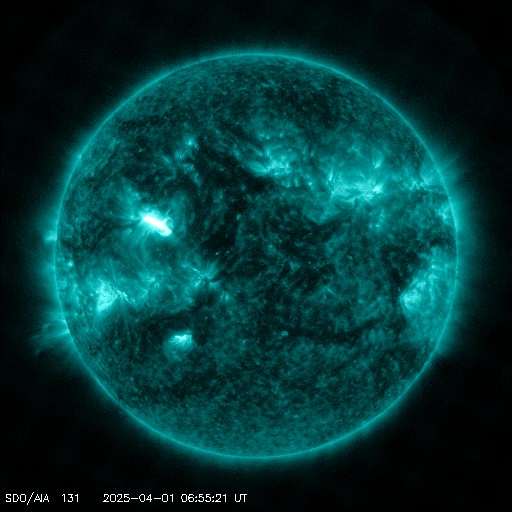Viewing archive of Saturday, 2 January 2016
Solar activity report
Any mentioned solar flare in this report has a scaling factor applied by the Space Weather Prediction Center (SWPC). Because of the SWPC scaling factor, solar flares are reported as 42% smaller than for the science quality data. The scaling factor has been removed from our archived solar flare data to reflect the true physical units.
Report of Solar-Geophysical Activity 2016 Jan 02 2200 UTCPrepared by the NOAA © SWPC and processed by SpaceWeatherLive.com
Joint USAF/NOAA Report of Solar and Geophysical Activity
SDF Number 2 Issued at 2200Z on 02 Jan 2016IA. Analysis of Solar Active Regions and Activity from 01-2100Z to 02-2100Z
Solar activity has been at moderate levels for the past 24
hours. The largest solar event of the period was a M2 event observed at
02/0011Z from Region 2473 (S21W89). There are currently 4 numbered
sunspot regions on the disk.
IB. Solar Activity Forecast
Solar activity is expected to be low with
a chance for M-class flares and a slight chance for an X-class flare on
day one (03 Jan) and expected to be very low with a chance for a C-class
flares on days two and three (04 Jan, 05 Jan).
IIA. Geophysical Activity Summary 01-2100Z to 02-2100Z
The geomagnetic
field has been at quiet to unsettled levels for the past 24 hours. Solar
wind speed, as measured by the ACE spacecraft, reached a peak speed of
511 km/s at 02/1313Z. Total IMF reached 9 nT at 02/0132Z. The maximum
southward component of Bz reached -6 nT at 02/0102Z. Protons greater
than 10 MeV at geosynchronous orbit reached a peak level of 21 pfu at
02/0450Z. Electrons greater than 2 MeV at geosynchronous orbit reached a
peak level of 4113 pfu.
IIB. Geophysical Activity Forecast
The geomagnetic field is expected
to be at quiet to major storm levels on day one (03 Jan), quiet to
active levels on day two (04 Jan) and quiet to unsettled levels on day
three (05 Jan). Protons greater than 10 Mev are expected to cross
threshold on day one (03 Jan) and have a chance of crossing threshold on
day two (04 Jan).
III. Event Probabilities 03 Jan to 05 Jan
| Class M | 40% | 05% | 05% |
| Class X | 10% | 01% | 01% |
| Proton | 90% | 30% | 01% |
| PCAF | yellow | ||
IV. Penticton 10.7 cm Flux
Observed 02 Jan 100 Predicted 03 Jan-05 Jan 100/100/100 90 Day Mean 02 Jan 109
V. Geomagnetic A Indices
Observed Afr/Ap 01 Jan 017/020 Estimated Afr/Ap 02 Jan 009/010 Predicted Afr/Ap 03 Jan-05 Jan 022/035-011/012-008/008
VI. Geomagnetic Activity Probabilities 03 Jan to 05 Jan
| A. Middle Latitudes | |||
|---|---|---|---|
| Active | 35% | 30% | 15% |
| Minor storm | 35% | 10% | 05% |
| Major-severe storm | 20% | 01% | 01% |
| B. High Latitudes | |||
|---|---|---|---|
| Active | 05% | 15% | 15% |
| Minor storm | 20% | 30% | 25% |
| Major-severe storm | 75% | 40% | 25% |
All times in UTC
Current data suggests there is a slight possibility for aurora to appear at the following high latitude regions in the near future
Gillam, MB, Iqaluit, NUNuuk
Reykjavik
Latest news
Latest forum messages
Unspecified geomagnetic activity 2180AR4048 82AR4046 152We are launching a dating app! SpaceWeatherLove! Download it today! 6Deep Flare Net 2
More topicsSupport SpaceWeatherLive.com!
A lot of people come to SpaceWeatherLive to follow the Sun's activity or if there is aurora to be seen, but with more traffic comes higher server costs. Consider a donation if you enjoy SpaceWeatherLive so we can keep the website online!

Latest alerts
01:45 UTC - Geomagnetic activity
Active geomagnetic conditions (Kp4) Threshold Reached: 01:32 UTC
Tuesday, 1 April 2025
22:51 UTC - Solar flare
Moderate M2.5 flare
22:30 UTC - Radio Blackout
Minor R1 radio blackout in progress (≥M1 - current: M1.45)
07:15 UTC - 10cm Radio Burst
Begin Time: 01/04/2025 06:45 UTC Maximum Time: 01/04/2025 06:45 UTC Duration: 1 minutes. Peak flux: 190 sfu
07:06 UTC - Solar flare
Strong M5.61 flare
Space weather facts
| Last X-flare | 2025/03/28 | X1.1 |
| Last M-flare | 2025/04/01 | M2.4 |
| Last geomagnetic storm | 2025/03/27 | Kp5 (G1) |
| Spotless days | |
|---|---|
| Last spotless day | 2022/06/08 |
| Monthly mean Sunspot Number | |
|---|---|
| February 2025 | 154.6 +17.6 |
| Last 30 days | 128.1 -22.5 |





